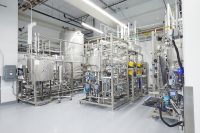In June, the USDA FSIS granted label approval and grant of inspection to two companies manufacturing cell-cultured meat: Upside Foods and Good Meat. This was the final step in the U.S. regulatory process, opening the door for commercialization. We spoke with Justin Dranschak, Director of BioPharma at Molecular Devices, about a potential timeline to sales, what this means for other manufacturers of lab-grown meat products and what impact these products may have on the U.S. and international food supply. A former employee with the Ohio Department of Agriculture and Siliker Labs, Dranschak has been working on cell line development for the past 10 years.
The FDA recently announced that it had no further questions about the safety of two cell-cultured meat products, which then went on to gain USDA grant of inspection and label approval. Can Upside Foods and Good Meat now sell their products commercially, and are these products ready for commercialization?
Dranschak: These approvals mean they can come to market, so the companies can now move forward with full-scale biofabrication. In terms of commercialization, there are still some challenges in terms of achieving price parity with meats now sold at the store level. The next step is optimizing production and scaling up the capacity of these systems. Everything up to now has been done on a small to medium scale, with a focus on thorough, rigorous testing. Scaling up from small to medium to large is a big challenge, and we’ve seen that in a lot of biological workflows as you’re dealing with different types of cells. They will need to optimize production and consistency of quality to ensure what they’re putting out in stores really matches what customers are looking for.
I recently saw a speaker who noted that the amount of meat or cells you need to create a final product is really not efficient or optimized? Has that been remedied or does that continue to be a challenge?
Dranschak: That is probably the No. 1 issue that is being looked at from a development perspective. But there are a lot of novel breakthroughs that are just on the periphery in terms of different styles of growth media that we can use, and different styles of vats and containers that we can use to ensure that the cells are getting correct feeding at the correct time and that you are then moving those onto the next step of the process at the right time. There are new technologies for monitoring and visualizing those cells. But those scaling efforts are the obstacle right now.
When developing lab grown meat, what is the manufacturing process?
Dranschak: The process starts with instrumentation called single cell printers. The company starts with a single cell taken from an animal, whichever animal they are using, and then they identify the cells of interest and put those in a machine that is then going to dispense a single cell into a 96-well plate. From there, they track that cell as it grows and multiplies. As you grow and multiply those cells, you also need to monitor them over time and prove that they did start from a single cell—that’s proof of monoclonality and that is what the FDA requires. The FDA wants to know where that cell came from and also the stability—ensuring that cell is not going to change or modify over time.
Once you’ve identified that you have these cells that match all the desired characteristics, that’s when you move into quality and production scale. At this point, you’re interested in things such as nutritional content and also biological content. Are the proteins in these cells the same as what we would see in regular chicken or fish? Are we seeing the same levels as we increase the number cells that we are producing in these vats? So, it comes down to a number of different groups working together in tandem to produce cell lines that are going to taste how consumer expect them to taste, and to ensure consistency over time.
If you start with a chicken, for example, and you extract some cells, do you then need to do that extraction for each future piece of chicken or can you build your own cell bank that becomes your product base?
Dranschak: You create a cell bank. These companies are developing thousands of cells and cell banks, and as they go through their processes they’re learning from each cell bank—identifying cells or methods that might over-produce or under-produce something. These cells are held for future learning so they can call on them at any time for development purposes or for future production runs.
What is the timeline in terms of producing a final product from a single cell?
Dranschak: It can take anywhere from 12 to 18 months up to 3 years. When looking at food versus a biological therapeutic, it’s a much more defined process, so I do see significant opportunities for shortening that cycle using automation—moving from more manual processes and synergizing those with robotics to move things in a higher capacity through the system. With advancements in AI and software, we’re also going to see a lot of process optimization in terms of the actual building design of these systems and incorporating the safety and sterilization processes that we have in pharmaceuticals and biotech back into the food industry for development.
Are there differences in terms of progress in the areas of development of cell-cultured poultry products vs. beef or seafood?
Dranschak: In terms of the path forward, this [FDA and USDA approvals] represents a major step because it provides a regulatory roadmap for the food industry and other industries using cell-cultured products. That being said, each process is different. Each cell line and each cell type has its own unique challenges in terms of how they grow, taste, function, etc. But the overall framework from a regulatory perspective has been set.
There is some wariness about cell-cultured meat, even within the food industry, are there unique safety concerns for lab grown meat?
Dranschak: They are largely the same. I previously worked in a food analytical lab doing microbiological testing with Siliker Laboratories. You’re going to be performing the exact same tests from the pathogen level as well as from a food characterization level. The main difference is the manufacturing process, and all of that has been extensively documented. It is extremely safe. Lab-grown meat does come with challenges from a public health perspective because it is something new. Overcoming that challenge requires education.
To me, this is an amazing and positive step forward. It offers us an opportunity to meet food challenges in parts of the world where, for example, they are unable to have access to meat on a regular basis. Lab grown meat allows us to address global food crises and support global health through science and the development of new products.






